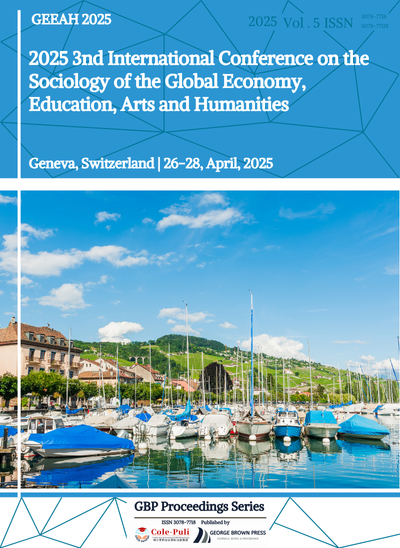Analysis of the Meaning Construction of Internet Buzzwords from the Perspective of Conceptual Integration Theory
DOI:
https://doi.org/10.71222/gx2w1x08Keywords:
conceptual integration theory, Internet buzzwords, meaning construction, cognitive mechanismAbstract
With the rapid development of the Internet, Internet buzzwords have emerged as distinct language variants that play a significant role in social media and daily conversations. These buzzwords reflect the current trends and can often represent the key social topics and issues that capture widespread attention at a given time. This paper conducts a quantitative analysis using a corpus collected from the annual buzzword list of the authoritative White Paper "Language and Writing Weekly" from 2010 to 2022. By applying conceptual integration theory — specifically the four network models: Simplex, Mirror, Single-Scope, and Double-Scope — this study explores how Internet buzzwords are generated, how their meanings are constructed, and interprets the dynamic cognitive processes involved. This research offers fresh insights into the cognitive mechanisms underlying the formation of Internet buzzwords.
References
1. Y. T. Sun and W. C. Gao, "A study on Internet buzzwords in the last four years based on conceptual integration theory," J. Lit. Art Stud., vol. 14, no. 8, pp. 711–717, 2024, doi: 10.17265/2159-5836/2024.08.009.
2. M. Chang, "Sociolinguistics of Chinese internet slang: Viral buzzwords (2019–2023)," in Connecting Ideas, Cultures, and Com-munities, pp. 154–159, Routledge, 2025. ISBN: 9781032502522.
3. F. Hong, C. Luo, and L. Xu, "Research on the influence of internet popular words on the values of contemporary college stu-dents and countermeasures," Int. J. Soc. Sci. Educ. Res., vol. 9, no. 4, 2024, doi: 10.46609/IJSSER.2024.v09i04.009.
4. S. Liu, H. Liu, and Y. Zhang, "The popularity of 'X Gou': Analysis of Internet buzzwords from the perspective of memetics."
5. H. Ren and X. Cheng, "A study on the construction of national image by the variation of network buzzwords from the per-spective of sociolinguistics," J. New Media Econ., vol. 1, no. 2, pp. 133, 2024, doi: 10.62517/jnme.202410222.
6. N. X. Liu, "Discursive power in the hybrid media system: The case of Chinese neologisms," Media Intercult. Commun., vol. 2, no. 2, pp. 21–38, 2024, doi: 10.22034/mic.2024.454362.1018.
7. X. Liu, "An analysis of 'discursion-power' in network buzzwords: A case study of Lone Warrior," Open J. Soc. Sci., vol. 12, no. 10, pp. 200–214, 2024, doi: 10.4236/jss.2024.1210016.
8. B. A. I. Jie, "Intercultural communication of Chinese new media language in the context of globalization," News NUUz, vol. 1, no. 1.2, pp. 301–305, 2024, doi: 10.69617/uzmu.v1i1.2.1068.
9. S. Zhang, Z. Ma, H. Li, Y. Liu, L. Chen, and K. C. Li, "Gender opposition recognition method fusing emojis and multi-features in Chinese speech," Soft Comput., vol. 29, no. 4, pp. 2379–2390, 2025, doi: 10.1007/s00500-025-10492-4.
10. L. Ma, R. Niu, W. Zhang, and Y. Mu, "Logistic regression and XGBoost model of multiple factors on Neijuan," in IEEE 7th Int. Conf. Inf. Technol., Netw., Electron. Autom. Control Conf. (ITNEC), vol. 7, pp. 183–187, 2024, doi: 10.1109/ITNEC60942.2024.10733149.
11. Y. Zhao, "A study of disease metaphors in network language," in 5th Int. Conf. Lang., Art, Cult. Exchange (ICLACE 2024), pp. 335–341, Atlantis Press, 2024, doi: 10.2991/978-2-38476-265-1_40.
12. J. Liang and L. Hyun, "Meme and label: Media convergence and digital visibility of 'Mutai Danshen' in Chinese audiovisual media," Convergence, 2024, doi: 10.1177/13548565251328766.











